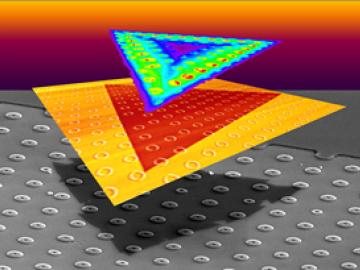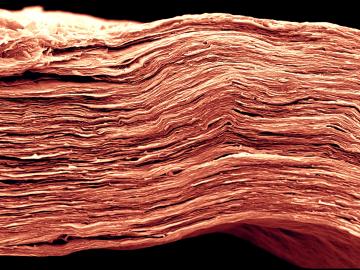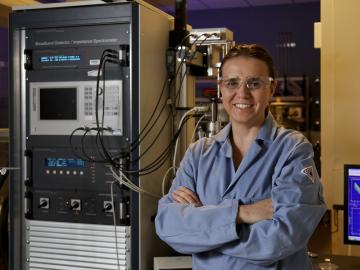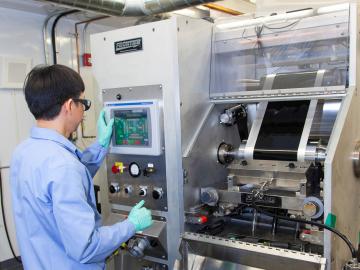
Filter News
Area of Research
- (-) Energy Science (129)
- (-) Materials (111)
- Advanced Manufacturing (2)
- Biology and Environment (65)
- Biology and Soft Matter (1)
- Computational Engineering (1)
- Computer Science (6)
- Electricity and Smart Grid (3)
- Energy Frontier Research Centers (1)
- Energy Sciences (1)
- Functional Materials for Energy (2)
- Fusion and Fission (14)
- Fusion Energy (7)
- Isotope Development and Production (2)
- Isotopes (7)
- Materials for Computing (13)
- Mathematics (1)
- National Security (14)
- Neutron Science (34)
- Nuclear Science and Technology (18)
- Nuclear Systems Modeling, Simulation and Validation (1)
- Quantum information Science (9)
- Sensors and Controls (1)
- Supercomputing (67)
News Topics
- (-) Advanced Reactors (9)
- (-) Biotechnology (4)
- (-) Energy Storage (85)
- (-) Grid (40)
- (-) Irradiation (1)
- (-) Nanotechnology (41)
- (-) Physics (28)
- (-) Quantum Science (12)
- (-) Space Exploration (5)
- 3-D Printing/Advanced Manufacturing (90)
- Artificial Intelligence (13)
- Big Data (7)
- Bioenergy (30)
- Biology (12)
- Biomedical (10)
- Buildings (38)
- Chemical Sciences (33)
- Clean Water (10)
- Composites (19)
- Computer Science (36)
- Coronavirus (14)
- Critical Materials (19)
- Cybersecurity (10)
- Environment (64)
- Exascale Computing (3)
- Fossil Energy (2)
- Frontier (3)
- Fusion (7)
- High-Performance Computing (9)
- Hydropower (3)
- Isotopes (13)
- ITER (1)
- Machine Learning (10)
- Materials (94)
- Materials Science (90)
- Mathematics (3)
- Mercury (3)
- Microelectronics (1)
- Microscopy (29)
- Molten Salt (3)
- National Security (6)
- Neutron Science (42)
- Nuclear Energy (22)
- Partnerships (16)
- Polymers (21)
- Quantum Computing (3)
- Security (7)
- Simulation (4)
- Statistics (1)
- Summit (6)
- Transportation (70)
Media Contacts

A new method developed at Oak Ridge National Laboratory improves the energy efficiency of a desalination process known as solar-thermal evaporation.

A team of researchers at Oak Ridge National Laboratory have demonstrated that designed synthetic polymers can serve as a high-performance binding material for next-generation lithium-ion batteries.

Scientists have discovered a way to alter heat transport in thermoelectric materials, a finding that may ultimately improve energy efficiency as the materials

A team led by scientists at the Department of Energy’s Oak Ridge National Laboratory explored how atomically thin two-dimensional (2D) crystals can grow over 3D objects and how the curvature of those objects can stretch and strain the

OAK RIDGE, Tenn., May 7, 2019—Energy Secretary Rick Perry, Congressman Chuck Fleischmann and lab officials today broke ground on a multipurpose research facility that will provide state-of-the-art laboratory space

Ionic conduction involves the movement of ions from one location to another inside a material. The ions travel through point defects, which are irregularities in the otherwise consistent arrangement of atoms known as the crystal lattice. This sometimes sluggish process can limit the performance and efficiency of fuel cells, batteries, and other energy storage technologies.

Scientists at Oak Ridge National Laboratory have developed a low-cost, printed, flexible sensor that can wrap around power cables to precisely monitor electrical loads from household appliances to support grid operations.


Vera Bocharova at the Department of Energy’s Oak Ridge National Laboratory investigates the structure and dynamics of soft materials.

The use of lithium-ion batteries has surged in recent years, starting with electronics and expanding into many applications, including the growing electric and hybrid vehicle industry. But the technologies to optimize recycling of these batteries have not kept pace.


